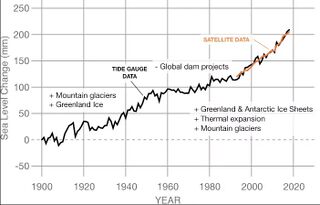Sea level rise: Difference between revisions
From Climate State Wiki
No edit summary |
No edit summary |
||
| Line 1: | Line 1: | ||
[[File:Sea-Level-Rise-1900-2018 NASA.jpg|thumb|320px|NASA’s Goddard Space Flight Center/PO.DAAC]] | [[File:Sea-Level-Rise-1900-2018 NASA.jpg|thumb|320px|NASA’s Goddard Space Flight Center/PO.DAAC]] | ||
Between 1901 and 2018, the average global sea level rose by 15–25 cm (6–10 in), or 1–2 mm per year.<ref>IPCC Report (2019) [https://www.ipcc.ch/srocc/ Summary for Policymakers]</ref> This rate is increasing; sea levels are now rising at a rate of 3.7 mm (0.146 inches) per year.<ref>IPCC Report (2021) [https://www.ipcc.ch/report/ar6/wg1/ Climate Change 2021: The Physical Science Basis]</ref> Human-caused climate change is predominantly the cause, as it constantly heats (and thus expands) the ocean and melts land-based ice sheets and glaciers.<ref>Matthias Mengel, Anders Levermann, Katja Frieler, Alexander Robinson, Ben Marzeion, and Ricarda Winkelmann (2016) [https://www.ncbi.nlm.nih.gov/pmc/articles/PMC4791025/ Future sea level rise constrained by observations and long-term commitment] Proceedings of the National Academy of Sciences</ref> | Between 1901 and 2018, the average global sea level rose by 15–25 cm (6–10 in), or 1–2 mm per year.<ref>IPCC Report (2019) [https://www.ipcc.ch/srocc/ Summary for Policymakers]</ref> This rate is increasing; sea levels are now rising at a rate of 3.7 mm (0.146 inches) per year.<ref>IPCC Report (2021) [https://www.ipcc.ch/report/ar6/wg1/ Climate Change 2021: The Physical Science Basis]</ref> Human-caused climate change is predominantly the cause, as it constantly heats (and thus expands) the ocean and melts land-based ice sheets and glaciers.<ref>Matthias Mengel, Anders Levermann, Katja Frieler, Alexander Robinson, Ben Marzeion, and Ricarda Winkelmann (2016) [https://www.ncbi.nlm.nih.gov/pmc/articles/PMC4791025/ Future sea level rise constrained by observations and long-term commitment] Proceedings of the National Academy of Sciences</ref> Between 1993 and 2018, thermal expansion of water contributed 42% to sea level rise (SLR); melting of temperate glaciers contributed 21%; Greenland contributed 15%; and Antarctica contributed 8%.<ref>WCRP Global Sea Level Budget Group (2018) [https://essd.copernicus.org/articles/10/1551/2018/ Global sea-level budget 1993–present] Earth System Science Data</ref> | ||
==References== | ==References== | ||
Revision as of 18:41, 4 May 2023
Between 1901 and 2018, the average global sea level rose by 15–25 cm (6–10 in), or 1–2 mm per year.[1] This rate is increasing; sea levels are now rising at a rate of 3.7 mm (0.146 inches) per year.[2] Human-caused climate change is predominantly the cause, as it constantly heats (and thus expands) the ocean and melts land-based ice sheets and glaciers.[3] Between 1993 and 2018, thermal expansion of water contributed 42% to sea level rise (SLR); melting of temperate glaciers contributed 21%; Greenland contributed 15%; and Antarctica contributed 8%.[4]
References
- ↑ IPCC Report (2019) Summary for Policymakers
- ↑ IPCC Report (2021) Climate Change 2021: The Physical Science Basis
- ↑ Matthias Mengel, Anders Levermann, Katja Frieler, Alexander Robinson, Ben Marzeion, and Ricarda Winkelmann (2016) Future sea level rise constrained by observations and long-term commitment Proceedings of the National Academy of Sciences
- ↑ WCRP Global Sea Level Budget Group (2018) Global sea-level budget 1993–present Earth System Science Data
